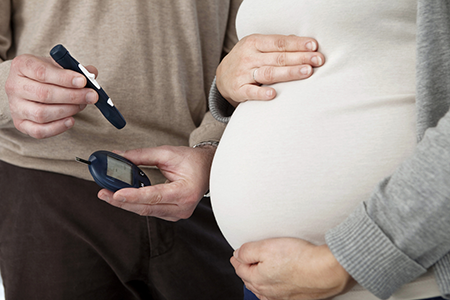 Gestational diabetes is a type of diabetes that is first seen in a pregnant woman who did not have diabetes before she was pregnant. Some women have more than one pregnancy affected by gestational diabetes. Gestational diabetes usually shows up in the middle of pregnancy. Doctors most often test for it between 24 and 28 weeks of pregnancy.
Gestational diabetes is a type of diabetes that is first seen in a pregnant woman who did not have diabetes before she was pregnant. Some women have more than one pregnancy affected by gestational diabetes. Gestational diabetes usually shows up in the middle of pregnancy. Doctors most often test for it between 24 and 28 weeks of pregnancy.
Often, gestational diabetes can be controlled through eating healthy foods and regular exercise. Sometimes, a woman with gestational diabetes must also take insulin.
Problems of gestational diabetes in pregnancy
Blood sugar that is not well controlled in a woman with gestational diabetes can lead to problems for the pregnant woman and the baby:
An extra large baby
Diabetes that is not well controlled causes the baby's blood sugar to be high. The baby is "overfed" and grows extra large. Besides causing discomfort to the woman during the last few months of pregnant, an extra large baby can lead to problems during delivery for both the mother and the baby. The mother might need a C-section to deliver the baby. The baby can be born with nerve damage due to pressure on the shoulder during delivery.
C-section (Cesarean section)
A C-section is an operation to deliver the baby through the mother's belly. A woman who has diabetes that is not well controlled has a higher chance of needing a C-section to deliver the baby. When the baby is delivered by a C-section, it takes longer for the woman to recover from childbirth.
High blood pressure (preeclampsia)
When a pregnant woman has high blood pressure, protein in her urine, and often swelling in fingers and toes that doesn't go away, she might have preeclampsia. It is a serious problem that needs to be watched closely and managed by her doctor. High blood pressure can cause harm to both the woman and her unborn baby. It might lead to the baby being born early and could also cause seizures or a stroke (a blood clot or a bleed in the brain that can lead to brain damage) in the woman during labor and delivery. Women with diabetes have high blood pressure more often than women without diabetes.
Low blood sugar (hypoglycemia)
People with diabetes who take insulin or other diabetes medications can develop blood sugar that is too low. Low blood sugar can be very serious, and even fatal, if not treated quickly. Seriously low blood sugar can be avoided if women watch their blood sugar closely and treat low blood sugar early.
If a woman's diabetes was not well controlled during pregnancy, her baby can very quickly develop low blood sugar after birth. The baby's blood sugar must be watched for several hours after delivery.
Five tips for women with gestational diabetes
1. Eat healthy foods
Eat healthy foods from a meal plan made for a person with diabetes. A dietician can help you create a healthy meal plan. Learn more about diabetes meal planning.
A dietician can also help you learn how to control your blood sugar while you are pregnant. To find a registered dietician near your, please visit The Academy of Nutrition and Dietetics website.
2. Exercise regularly
Exercise is another way to keep blood sugar under control. It helps to balance food intake. After checking with your doctor, you can exercise regularly during and after pregnancy. Get at least 30 minutes of moderate-intensity physical activity at least five days a week. This could be brisk walking, swimming, or actively playing with children. Learn more about physical activity during pregnancy.
3. Monitor blood sugar often
Because pregnancy causes the body's need for energy to change, blood sugar levels can change very quickly. Check your blood sugar often, as directed by your doctor.
4. Take insulin, if needed
Sometimes a woman with gestational diabetes must take insulin. If insulin is ordered by your doctor, take it as directed in order to help keep blood sugar under control.
5. Get tested for diabetes after pregnancy
Get tested for diabetes six to 12 weeks after your baby is born, and then every one to three years. For most women with gestational diabetes, the diabetes goes away soon after delivery. When it does not go away, the diabetes is called type 2 diabetes. Even if the diabetes does go away after the baby is born, half of all women who had gestational diabetes develop type 2 diabetes later. It's important for a woman who has had gestational diabetes to continue to exercise and eat a healthy diet after pregnancy to prevent or delay getting type 2 diabetes. She should also remind her doctor to check her blood sugar every one to three years.
More information
View, download, and print this brochure about gestational diabetes and pregnancy.
For more information on gestational diabetes, visit the American Diabetes Association's website.
